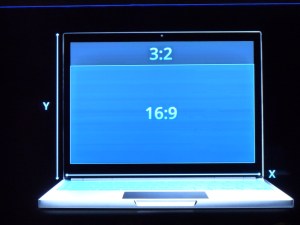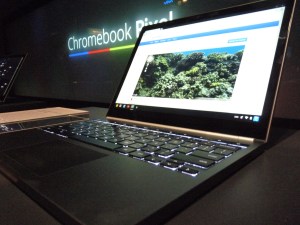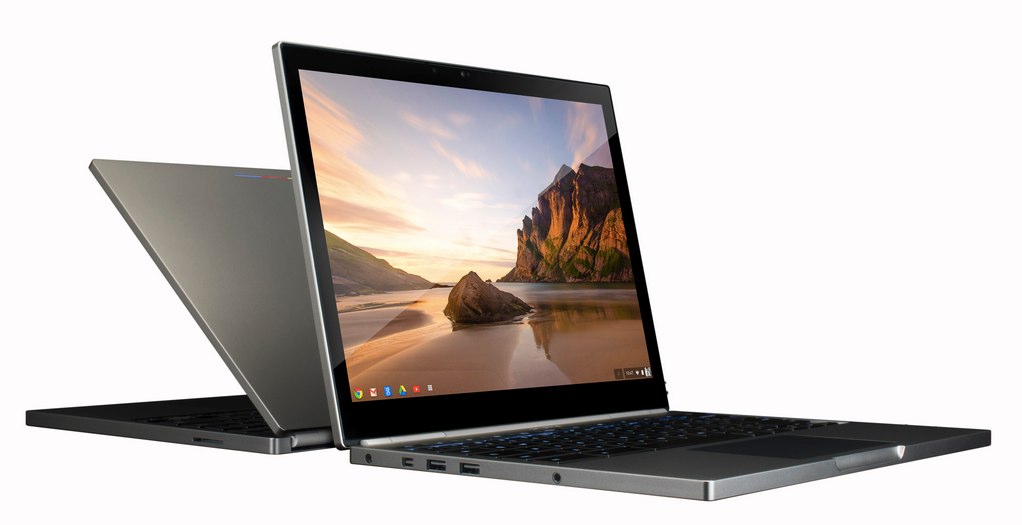The Chromebook Pixel is the best Chromebook ever made. As with all Chromebooks, that may mean nothing to you if you don’t like ChromeOS, but there can be little doubt that the Pixel is a beautiful piece of precision engineering that feels like a premium laptop that wouldn’t be out of place in any line-up of $1,000+ laptops. And that’s before you even look at the 12.86″ touchscreen with the unusual, but very useful, 3:2 aspect ratio, which beats Apple’s Retina displays in terms of pixel density.
If there is a controversy around the Pixel, it’s not about whether this is a great piece of hardware, because it unquestionably is. The question is whether it is worth the $1,299 Google charges for the Wi-Fi version and $1,449 for the LTE-enabled version. If the other Chromebooks, which start at more than $1,000 less than the Pixel are semi-disposable machines that you can easily replace when they break and which are making their inroads into classrooms and enterprises because of this, the Pixel is basically the Chromebook for the C-suite and the superintendent.
A Premium Chromebook At A Premium Price
Let’s look at the device itself before jumping to too many conclusions, though. On the outside, it only has a very muted appearance, with its dark aluminum body and silver piano hinge that features an understated Chrome logo. It’s a bit on the heavy side and at 3.35 pounds, it obviously has a bit more heft than a 13 inch MacBook Air, though given its touchscreen, it may actually be fairer to compare the Pixel to something like the Lenovo Yoga 13, which weighs just about the same as the Pixel.
The coolest feature on the outside, must be the slim LED bar that lights up in a light blue when the machine is on and displays the full range of the Pixel’s signature colors when you open it and shut it down. There’s nothing useful about this, but it’s a good example for the thoughtful design that makes the Pixel stand out from its competitors.
![]() The Pixel actually features many of these small little features that would definitely appear on a slide at an Apple keynote. The power brick has a little groove that you can run your cable through, makes it a bit easier to keep it halfway organized. The backlight on the keyboard dims when you play a video in full-screen mode. Indeed, the chiclet keyboard, too, feels just right and after a few days with the Pixel, I would argue that it’s better than what Apple is currently shipping on its MacBooks. Of course, it also features Google’s standard Chrome keyboard layout, which does away with Caps Lock and other underused keys in favor of a search key (which brings up the apps menu on the Pixel) and a tighter layout.
The Pixel actually features many of these small little features that would definitely appear on a slide at an Apple keynote. The power brick has a little groove that you can run your cable through, makes it a bit easier to keep it halfway organized. The backlight on the keyboard dims when you play a video in full-screen mode. Indeed, the chiclet keyboard, too, feels just right and after a few days with the Pixel, I would argue that it’s better than what Apple is currently shipping on its MacBooks. Of course, it also features Google’s standard Chrome keyboard layout, which does away with Caps Lock and other underused keys in favor of a search key (which brings up the apps menu on the Pixel) and a tighter layout.
As for the other specs, the Pixel features a dual-core Intel i5 processor, has two USB ports, a mini display port for adding an external display, dual-band Wi-Fi, Bluetooth 3.0 and a built-in SD/MMC card reader.
This is a Chromebook, so on-device storage is very limited (32GB for the Wi-Fi model, 64GB for the LTE version). To make up for this, Google offers Pixel users a full terabyte of free Google Drive storage for the next three years. It’s not clear what will happen after this time, which Google says is the expected lifetime of a laptop these days.
The 3:2 Screen
![]() In the end, the Pixel is all about the screen, though. When it comes to touchscreens, Windows 8 Ultrabooks have the market to themselves right now and I’m not aware of any of those having the kind of pixel density as the Pixel ( 2,560 x 1,700 at 239 PPI). Google pre-installs a version of the TimeScapes trailer (which was originally shot as a 4k video) on every Pixel to show off the quality of the display and that alone makes for a pretty stunning experience. As everybody who has ever used a laptop with a Retina display knows, text also looks great on such a high-DPI screen and going back to a regular screen just feels like a major step back.
In the end, the Pixel is all about the screen, though. When it comes to touchscreens, Windows 8 Ultrabooks have the market to themselves right now and I’m not aware of any of those having the kind of pixel density as the Pixel ( 2,560 x 1,700 at 239 PPI). Google pre-installs a version of the TimeScapes trailer (which was originally shot as a 4k video) on every Pixel to show off the quality of the display and that alone makes for a pretty stunning experience. As everybody who has ever used a laptop with a Retina display knows, text also looks great on such a high-DPI screen and going back to a regular screen just feels like a major step back.
Just like Apple, Google uses those more than 4 million pixels to simulate a significantly lower resolution than the screen is capable off (I’m guessing it’s about 1280 points wide). This allows it to use font smoothing that goes a few steps further than what hardware developers are capable of with regular displays. Here is a screenshot of what the desktop looks like in its full 2,560 by 1,700 glory.
 Google says it chose a display with a 3:2 aspect ratio because most content on the web is not designed for widescreen displays, so going with a 3:2 screen gives you more horizontal screen estate. This, however, also means you can’t really put two browser windows side-by-side. ChromeOS solves this by using a Windows-like snap-to-edge gesture that automatically expands the active window to cover mot of the screen when you drag it to the edge of the display. Do this with two windows on each side of the screen and you can easily switch back and forth between them – or you could just use Ctrl-Tab to switch between browser tabs.
Google says it chose a display with a 3:2 aspect ratio because most content on the web is not designed for widescreen displays, so going with a 3:2 screen gives you more horizontal screen estate. This, however, also means you can’t really put two browser windows side-by-side. ChromeOS solves this by using a Windows-like snap-to-edge gesture that automatically expands the active window to cover mot of the screen when you drag it to the edge of the display. Do this with two windows on each side of the screen and you can easily switch back and forth between them – or you could just use Ctrl-Tab to switch between browser tabs.
Talking about the edge of the screen, it looks like the top and bottom of the glass that surrounds the display is also touch-enabled. Currently, you can only use this to swipe the taskbar into view at the bottom of the screen, but there is an option in the chrome://flags settings that allows you to enable “bezel touch actions.” That setting doesn’t seem to do much right now, but that could change in upcoming versions of ChromeOS.
U Can Touch This
 At first, touching the screen feels a bit weird. It’s just not something you’re supposed to do. Unlike the Yoga, you also can’t fold it back 180 degrees and just use it as a tablet, so the keyboard is always between you and the screen (and there is no on-screen keyboard anyway). Still, when you sit back and read, scrolling down the page with your fingers on the left or right hand of the screen actually starts making sense after a while.
At first, touching the screen feels a bit weird. It’s just not something you’re supposed to do. Unlike the Yoga, you also can’t fold it back 180 degrees and just use it as a tablet, so the keyboard is always between you and the screen (and there is no on-screen keyboard anyway). Still, when you sit back and read, scrolling down the page with your fingers on the left or right hand of the screen actually starts making sense after a while.
The same goes for using Google maps or full-screen visual experiences like 100,000 Stars. My guess is that 95 percent of the time, you will just use the trackpad (which also feels great, by the way). When you’re just kicking back and want to read a 1,500 word review on TechCrunch, using the touchscreen to scroll down the page starts making sense. First, though, you have to get over the taboo of touching the screen. Once I got past that point, I often found myself reaching out to the screen to close a tab instead of using the trackpad or to click a bookmark. I’m not sure if that’s worth the premium, though, and that’s something you obviously have to decide yourself.
Battery Life
The big tradeoff of having this high-res screen, though, is that it needs quite a bit of battery power, something Google freely admitted when it revealed the Pixel during a mystery-shrouded press event last week (even the fact that there was a press event didn’t leak out). Google says the battery should last about five hours, and judging from my experience with the Pixel, that sounds about right, especially if you keep the screen brightness somewhere around the middle. Playing high-res videos (the 4k videos on YouTube clearly taxed the CPU and Intel 4000 GPU a bit too much and wouldn’t play without stutter, by the way) and 3D games (there are quite a few of those available in the Chrome Web Store now) will obviously drain the battery quite a bit faster.
For Those Few Who Live Exclusively In The Cloud
Google says the Pixel is meant to be a premium device for those who already live in the cloud. If that’s you – and you have some cash to burn – the Pixel may just be for you. In the end, though, the fact that it has a touchscreen may be irrelevant to most users and given that you can buy a Macbook Air or touch-enabled Windows 8 Ultrabook for significantly less than a Pixel, will make it a hard sell despite its amazing screen.
If you are that person who lives in the cloud, the Pixel may just be an option for you (especially once Google lets you edit all your old-school Microsoft Office documents with Quickoffice for Chrome in the coming months). For virtually everybody else, though, this is going to be a hard expense to justify. The hardware is amazing (and did I mention the screen?), but unless you want to use it as a premium Linux laptop with a very limited hard-drive capacity, ChromeOS will still regularly get in your way of getting things done.
It’s hard not to look at the Pixel, which was designed by Google itself, without thinking about the ill-fated Nexus Q media player the company introduced at Google I/O but never brought to market. The Q was Google’s first attempt at making its own hardware, and it, too, was a great, solid piece of hardware, but it was let down by the software that was running on it.
In its current state – and at its current price – the Pixel is essentially a Nexus-like reference design for what a high-end Chromebook should look like (though Google definitely isn’t positioning it this way). It’s a beautiful machine that would look good in any laptop manufacturer’s lineup, and it shows that Google hasn’t just found its design chops in software, but can now also produce great hardware. The only thing holding it back is ChromeOS…






























Comment